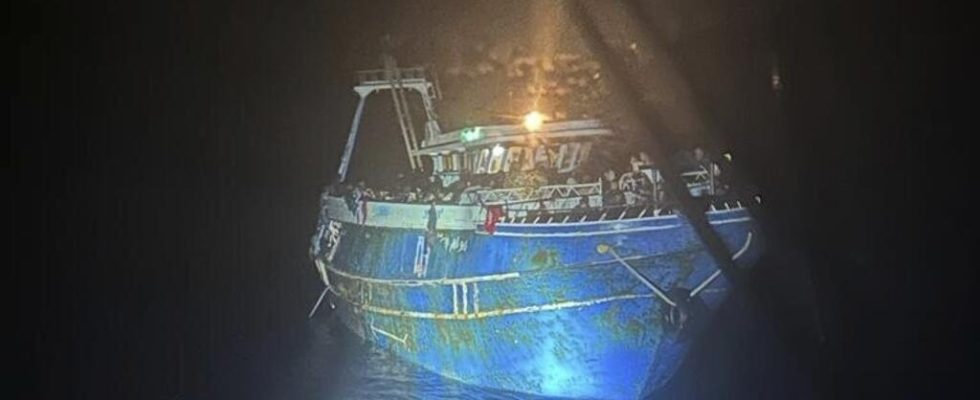A fishing vessel carrying nearly 750 migrants sank on the night of June 13 to 14 off Greece as it tried to reach Italy. He had taken a route hitherto unknown and yet increasingly popular: the one starting from the east of Libya.
It could be the deadliest shipwreck in the Mediterranean since that of April 2015, during which some 800 migrants were killed. On the night of June 13 to 14, a fishing boat that left Tobruk, Cyrenaica, capsized off the Peloponnese peninsula. A Greek government spokesman said the vessel broke down and sank within 15 minutes in very deep water. According to the testimonies of the survivors, around 750 people were on board, including several dozen children. For the time being, only 104 have been rescued and the hope of finding other survivors is dwindling as time passes.
This new drama challenges in more ways than one. First of all because of the nationality of the survivors. While migrants crossing the central Mediterranean from Tunisia and western Libya are mostly from sub-Saharan Africa, most of them came from Egypt, Syria and Pakistan. If the presence of Egyptians is hardly surprising – Tobruk is only 150 km from the Egyptian border – that of Syrians and Pakistanis is surprising. It shows the perpetual evolution of migratory routes, which form and disappear according to the measures introduced by the States crossed, but also according to the economic and geopolitical situation. ” When one road closes, another opens sums up Flavio Di Giacomo, spokesperson for the International Organization for Migration (IOM) in Italy.
>> To read also: On Infomigrants – Fleeing by sea and reaching Italy, the “inevitable fate” of thousands of Egyptians plagued by poverty
An increasingly busy road
For a long time, the route taken by Syrians and Pakistanis was that of the Balkans. The multiplication of pushbacks by the Greek coast guard – a practice that is illegal under European law – has prompted exiles to seek new ones. Libya, notably because of its geographical position, has naturally imposed itself as a gateway to Europe. Most arrive directly by air to Benghazi, in the northeast, or by road from Egypt. But instead of then joining the region of Tripoli, to the west, facing Sicily, it is directly from Tobruk, to the east, that they are now trying to reach Italy.
” Until September, only 15% of departures from Libya were from Cyrenaica. There was an increase in departures from Tobruk or Benghazi from October confirms Flavio Di Giacomo. From then on, the situation began to reverse. Of the approximately 22 000 people who have left Libya since the beginning of the year, the IOM notes that about 13 000 left Cyrenaica. A choice partly dictated by the instability of the country, the risks of kidnapping, murder and torture… But also because of the interception operations carried out by the coastguards of the government of Tripoli, which controls the West. The East, on the other hand, has systematically let through since the summer.
For how long ? At the beginning of May, Marshal Khalifa Haftar, the strongman of eastern Libya, traveled to Italy where he met with the President of the Council Giorgia Meloni, the Minister of the Interior and several other Italian officials. At the heart of their discussions, illegal immigration. Upon his return, thousands of undocumented Egyptians and candidates for departure were sent home, according to authorities in Benghazi. ” There are rumors of an increase in arrests in Cyrenaica by Marshal Haftar’s forces, confirms Flavio Di Giacomo, of the IOM. The traffickers therefore hasten to send as many migrants as possible. »
Increased risks
This new, longer route to Europe increases the risks run by migrants. Especially since the fishing vessels used for the crossing and capable of transporting several hundred people are particularly dilapidated. Another reason for concern: the lack of responsiveness for which the European coast guards are accused. ” The Italian, Maltese or Greek coast guards wait a long time before launching rescue operations, especially when the boats seem to have no problem. But even if they don’t appear to have any problem, they could capsize at any moment! “Warns Flavio Di Giacomo.
” This is a totally irresponsible attitude for us, in the sense that these boats are not able to continue their journey. They pose major risks to people on board. States have an obligation to rescue these boats, to bring people back to dry land, before examining their individual situation. “, adds Vincent Cochetel, special envoy of the United Nations High Commissioner for Refugees for the Central and Western Mediterranean.
Before this latest shipwreck, the International Organization for Migration counted 1 039 deaths in the Mediterranean since the beginning of the year. Not to mention all these “phantom shipwrecks”, those of which nothing is known except the bodies that are recovered, which could double this toll.
>> To read also: In Greece, after the sinking of a migrant boat, the authorities implicated
